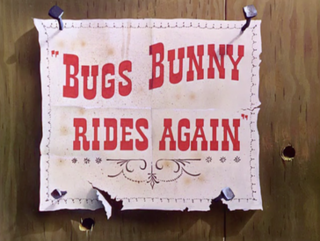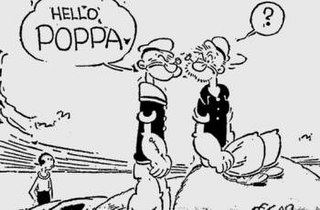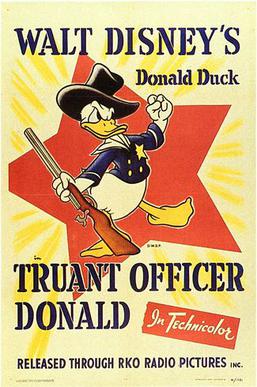
Bluto, at times known as Brutus, is a cartoon and comics character created in 1932 by Elzie Crisler Segar as a one-time character, named "Bluto the Terrible", in his Thimble Theatre comic strip. Bluto made his first appearance on September 12 of that year. Fleischer Studios adapted him the next year (1933) to be the main antagonist of their theatrical Popeye animated cartoon series.

Winfield Bennett Mercer, known professionally as Jack Mercer, was an American voice actor. He is best known as the voice of cartoon characters Popeye the Sailor Man and Felix the Cat. The son of vaudeville and Broadway performers, he also performed on the vaudeville and legitimate stages.

Mr. Duck Steps Out is a Donald Duck cartoon produced by Walt Disney Productions, which is released on June 7, 1940, and featured the debut of Daisy Duck. The short was directed by Jack King and written by Carl Barks, Chuck Couch, Jack Hannah, Harry Reeves, Milt Schaffer, and Frank Tashlin.

Popeye the Sailor Meets Ali Baba's Forty Thieves is a two-reel animated cartoon short subject in the Popeye Color Specials series, produced in Technicolor and released to theatres on November 26, 1937 by Paramount Pictures. It was produced by Max Fleischer for Fleischer Studios, Inc. and directed by Dave Fleischer. Willard Bowsky was head animator, with musical supervision by Sammy Timberg. The voice of Popeye is performed by Jack Mercer, with additional voices by Mae Questel as Olive Oyl, Lou Fleischer as J. Wellington Wimpy and Gus Wickie as Abu Hassan.

Bugs Bunny Rides Again is a 1948 Merrie Melodies animated short directed by Friz Freleng. The short was released on June 12, 1948, and stars Bugs Bunny and Yosemite Sam.

Poopdeck Pappy is a fictional character featured in the Popeye comic strip and animated cartoon spinoffs. Created by E. C. Segar in 1936, the character is Popeye's father, who is between the ages of 85 and 99.
Tick Tock Tuckered is a 1944 Warner Bros. Looney Tunes cartoon directed by Bob Clampett. The cartoon was released on April 8, 1944, and stars Porky Pig and Daffy Duck. This is a color remake of the cartoon Porky's Badtime Story (1937), with Daffy filling the role that was previously played by Gabby Goat. A gag from Friz Freleng's cartoon Notes to You (1941) was also reused as well, while a reference to The Dover Boys (1942) is briefly made.

Gulliver's Travels is a 1939 American animated musical fantasy film produced by Max Fleischer and directed by Dave Fleischer for Fleischer Studios. Released to cinemas in the United States on December 22, 1939, by Paramount Pictures, the story is a very loose adaptation of Jonathan Swift's 1726 novel of the same name, specifically only the first part of four, which tells the story of Lilliput and Blefuscu, and centers around an explorer who helps a small kingdom who declared war after an argument over a wedding song. The film was Fleischer Studios' first feature-length animated film, as well as the second animated feature film produced by an American studio after Walt Disney Productions' Snow White and the Seven Dwarfs, as Paramount had commissioned the feature in response to the success of that film. The sequences for the film were directed by Seymour Kneitel, Willard Bowsky, Tom Palmer, Grim Natwick, William Henning, Roland Crandall, Thomas Johnson, Robert Leffingwell, Frank Kelling, Winfield Hoskins, and Orestes Calpini.

Christmas Comes But Once a Year is a 1936 animated short produced by Fleischer Studios and released on December 4, 1936 by Paramount Pictures. It is part of the Color Classics series. The cartoon features Professor Grampy, a character from the Betty Boop series; this is the character's only appearance without Betty. An edited version was featured during the Pee-wee's Playhouse Christmas Special in 1988, as the featured short shown by the King of Cartoons.

The Monster Bed is a 1987 children's book by Jeanne Willis and illustrated by Susan Varley that revolves around the twist on the common "monsters under the bed" story that frighten children. The book is a young reader, normally aimed for 4 years or older. The main character, the monster Dennis, believes that human children are under his bed and will get him as he falls asleep. His mother, however, tries to get him to go to sleep. Eventually, a human child accidentally ventures into their home cave, and both the human and Dennis discover each other, frightening both.

Popeye the Sailor is an American animated television series produced for King Features Syndicate TV starring Popeye that was released between 1960 and 1963 with 220 episodes produced. The episodes were produced by multiple animation studios and aired in broadcast syndication until the 1990s.

Truant Officer Donald is an animated short film produced in Technicolor by Walt Disney Productions and released to theaters on August 1, 1941 by RKO Radio Pictures. The film was nominated for an Academy Award for Best Animated Short Film in 1942 but lost to another Disney cartoon, Lend a Paw. The story features Donald Duck working as a truant officer and making sure that Huey, Dewey, and Louie go to school. The film was directed by Jack King while Clarence Nash provided the voices of Donald and the nephews.

Popeye the Sailor is an American animated series of short films based on the Popeye comic strip character created by E. C. Segar. In 1933, Max and Dave Fleischer's Fleischer Studios, based in New York City, adapted Segar's characters into a series of theatrical cartoon shorts for Paramount Pictures. The plotlines in the animated cartoons tended to be simpler than those presented in the comic strips, and the characters slightly different. A villain, usually Bluto, makes a move on Popeye's "sweetie", Olive Oyl. The villain clobbers Popeye until he eats spinach, giving him superhuman strength. Thus empowered, Popeye makes short work of the villain.
Popeye Meets the Man Who Hated Laughter, also known as The Man Who Hated Laughter, is a 1972 American animated one-hour television special that was part of The ABC Saturday Superstar Movie. This film united characters from almost every newspaper comic strip then owned by King Features Syndicate in one story. The show aired on October 7, 1972, and was repeated in February 1974.

The Sea Hag is a fictional character owned by King Features Syndicate. She is a tall, masculine-looking witch featured in comics/cartoons as a nemesis to the character Popeye. The Sea Hag was created by Elzie Crisler Segar in 1929 as part of the Thimble Theatre comic strip.

Winston Singleton Sharples was an American composer known for his work with animated short subjects, especially those created by the animation department at Paramount Pictures. In his 35-year career, Sharples scored more than 700 cartoons for Paramount and Famous Studios, and composed music for two Frank Buck films, Wild Cargo (1934) and Fang and Claw (1935).

Popeye the Sailor is a fictional cartoon character created by Elzie Crisler Segar. The character first appeared on January 17, 1929, in the daily King Features comic strip Thimble Theatre. The strip was in its tenth year when Popeye made his debut, but the one-eyed sailor quickly became the lead character, and Thimble Theatre became one of King Features' most popular properties during the 1930s. Following Segar's death in 1938, Thimble Theatre was continued by several writers and artists, most notably Segar's assistant Bud Sagendorf. The strip continues to appear in first-run installments on Sundays, written and drawn by R. K. Milholland. The daily strips are reprints of old Sagendorf stories.

Blow me Down! is a Popeye theatrical cartoon short in the Paramount Picture short series. It was released in 1933 and was the third cartoon in the Popeye the Sailor series of theatrical cartoons released by Paramount Pictures. The title also corresponds to one of Popeye's most notable catchphrases.

Sea Scouts is an animated cartoon short film in the Donald Duck series. It was produced in Technicolor by Walt Disney Productions and released to theaters on June 30, 1939, by RKO Radio Pictures.

Donald's Off Day is a 1944 Walt Disney animated short by Jack Hannah starring Donald Duck and Huey, Louie and Dewey. It stars the nephews tricking Donald into thinking that he is seriously ill.

















